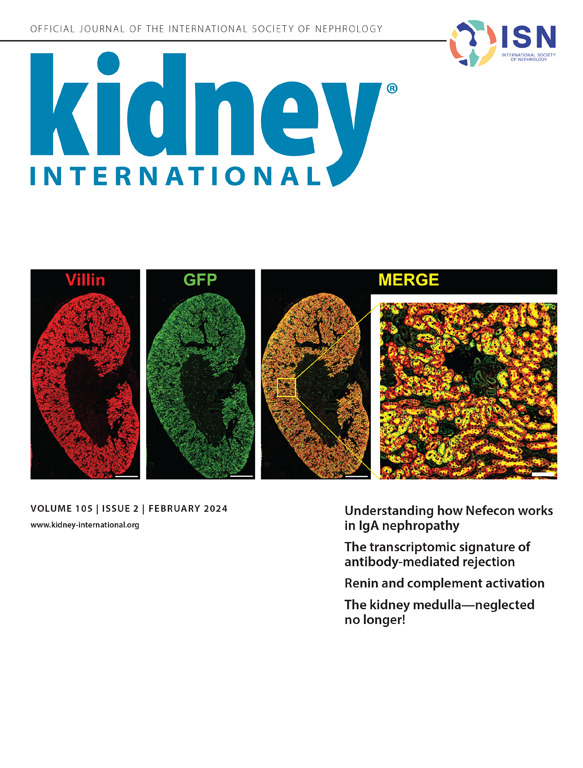B cell-derived exosomal miR-483-5p and its potential role in promoting kidney function loss in IgA nephropathy.
IF 14.8
1区 医学
Q1 UROLOGY & NEPHROLOGY
引用次数: 0
Abstract
INTRODUCTION While mesangial IgA deposition is the pathognomonic feature of IgA nephropathy (IgAN) the extent of mesangial IgA accumulation does not correlate with the future risk of kidney failure. This has led to the search for other serum factors that may influence clinical outcome. The emergence of microRNAs (miRs) as negative regulators of gene expression and the increasingly recognized role of extracellular miRs in intercellular communication has prompted study of the influence of miRs on inflammatory and scarring pathways in the kidneys. METHODS Here, next generation sequencing and subsequent qPCR validation identified a significant increase in the serum levels of miR-483-5p, largely packaged within exosomes. RESULTS Levels of miR-483-5p in serum exosomes were greatest in those IgAN patients with higher levels of proteinuria who subsequently developed kidney failure. Exosomal miR-483-5p content significantly correlated with numerous soluble isoforms of the tumor necrosis factor (TNF) receptor super family suggesting lymphocytes as a source of the miR-enriched exosomes. In PBMC miR-483- 5p expression was almost exclusively seen in CD19+ lymphocytes. Activation of a human IgA secreting B cell line with soluble TNFR1 induced miR-483-5p synthesis and enrichment within exosomes. Exposure to miR-483-5p-enriched B cell exosomes resulted in a proinflammatory phenotypic change in cultured human collecting duct epithelial cells, likely mediated through suppression of the transcription factor SOCS3. miR-483-5p-enriched exosomes were also present in the urine of patients with IgAN. CONCLUSIONS Interaction of B lymphocyte-derived miR-enriched exosomes with tubular epithelial cells may provide an explanation for the progressive tubulointerstitial scarring and loss of kidney function seen in IgAN.B细胞来源的外泌体miR-483-5p及其在IgA肾病中促进肾功能丧失的潜在作用
虽然肾小球系膜IgA沉积是IgA肾病(IgAN)的病理特征,但肾小球系膜IgA积累的程度与未来肾衰竭的风险无关。这导致了对可能影响临床结果的其他血清因素的研究。microRNAs (miRs)作为基因表达的负调节因子的出现,以及细胞外miRs在细胞间通讯中的作用日益被认识,促使了miRs对肾脏炎症和瘢痕通路影响的研究。在这里,下一代测序和随后的qPCR验证发现miR-483-5p的血清水平显着增加,主要包装在外泌体中。结果血清外泌体中miR-483-5p水平在随后发生肾衰竭的高水平蛋白尿IgAN患者中最高。外泌体miR-483-5p含量与肿瘤坏死因子(TNF)受体超家族的许多可溶性亚型显著相关,表明淋巴细胞是mir -富集外泌体的来源。在PBMC中,miR-483- 5p几乎只在CD19+淋巴细胞中表达。可溶性TNFR1激活人IgA分泌B细胞系诱导miR-483-5p在外泌体内合成和富集。暴露于mir -483-5p富集的B细胞外泌体导致培养的人收集管上皮细胞的促炎表型改变,可能是通过抑制转录因子SOCS3介导的。IgAN患者的尿液中也存在mir -483-5p富集的外泌体。结论B淋巴细胞来源的mir富集外泌体与小管上皮细胞的相互作用可能解释了IgAN中进行性小管间质瘢痕形成和肾功能丧失的原因。
本文章由计算机程序翻译,如有差异,请以英文原文为准。
求助全文
约1分钟内获得全文
求助全文
来源期刊

Kidney international
医学-泌尿学与肾脏学
CiteScore
23.30
自引率
3.10%
发文量
490
审稿时长
3-6 weeks
期刊介绍:
Kidney International (KI), the official journal of the International Society of Nephrology, is led by Dr. Pierre Ronco (Paris, France) and stands as one of nephrology's most cited and esteemed publications worldwide.
KI provides exceptional benefits for both readers and authors, featuring highly cited original articles, focused reviews, cutting-edge imaging techniques, and lively discussions on controversial topics.
The journal is dedicated to kidney research, serving researchers, clinical investigators, and practicing nephrologists.
 求助内容:
求助内容: 应助结果提醒方式:
应助结果提醒方式:


